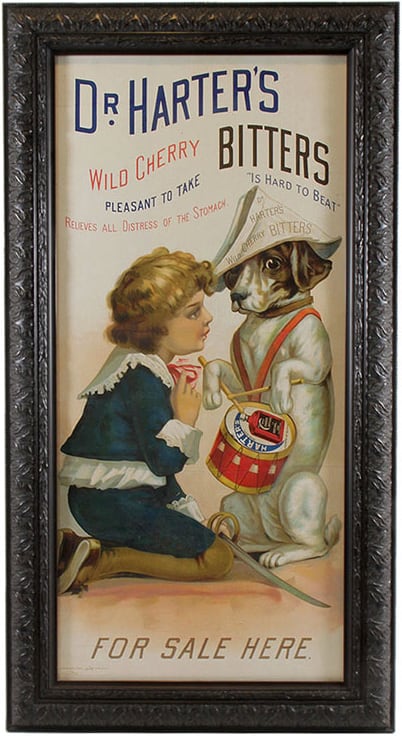 Dr. Harter’s Wild Cherry Bitters and the Bottle Gods
Dr. Harter’s Wild Cherry Bitters and the Bottle Gods
10 June 2012 (R•021514 Playing Cards added) (R•032214 Marriage Puzzle Card added) (R•111817 Top image added from AGG) (R•101018) (R•060320-H 51)
![]() Dennis Humphrey posted the following pictures over on the Peachridge Glass facebook page for a recently found shard and a new Dr. Harter’s Wild Cherry Bitters miniature in a gorgeous pale lemon yellow color. His enthusiasm is contagious. Congratulations Dennis!
Dennis Humphrey posted the following pictures over on the Peachridge Glass facebook page for a recently found shard and a new Dr. Harter’s Wild Cherry Bitters miniature in a gorgeous pale lemon yellow color. His enthusiasm is contagious. Congratulations Dennis!
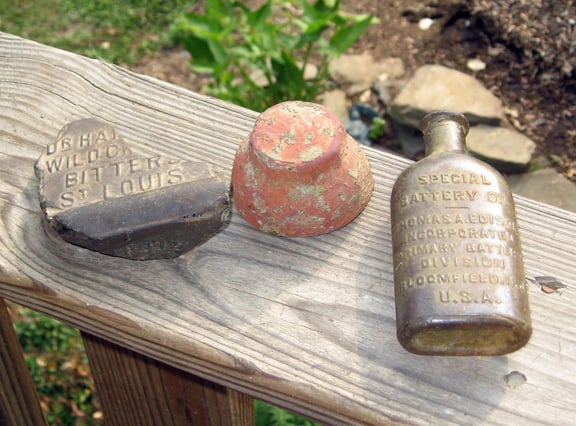
Went creek walking in Walker County, Alabama and thought it was gonna be a good day when I found a Dr Harter’s Wild Cherry Shard. – Dennis Humphrey (03 June 2012)
My buddy Bobby McGraw told me that if I find a good broken bottle or shard, to keep it and the Bottle Gods will bring you a better one. Remember the Dr Harter’s shard? Well here is a photo of the one I picked up today at the Atlanta Bottle Show in as light of color as I have seen. Can’t think of a better way to spend a Saturday. It is a dug bottle but I don’t care. I love this small little bottle.
Dennis Humphrey
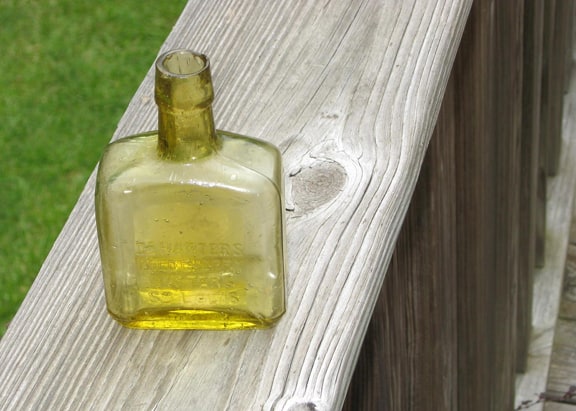
DR. HARTER’S WILD CHERRY BITTERS sample (H 52) – Dennis Humphrey (recent purchase at Atlanta Bottle Show)
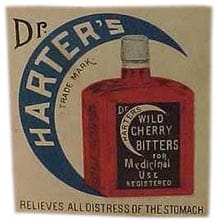 I like when fellow collectors send me pictures and stories as it prompts me to dig into my collection archives and to re-look at a certain brand.
I like when fellow collectors send me pictures and stories as it prompts me to dig into my collection archives and to re-look at a certain brand.
The Dr. Harter’s is fun because it is a later bottle and common, so you can find some great examples and material. A bottle does not have to be expensive.
DR. HARTER’S WILD CHERRY BITTERS
DR. HARTER’S MEDICINE CO. – St. Louis, Missouri (1855 – 1898)
The company was established in Saint Louis in 1855 (according to company advertising) by Milton George Harter, Samuel K. Harter and Thomas W. Boyer, believed to be from Ohio. Dr. M. G. Harter died around 1890.
In 1895, the business had relocated to Dayton, Ohio and by the end of the century had been taken over by the San Antonio Drug Company. The company’s products included Dr. Harter’s Fever and Ague Specific, Dr .Harter’s Fever and Ague Pills, Dr. Harter’s Pile Ointment, Dr. Harter’s Little Liver Pills – Do not Gripe or Sicken, Dr. Harter’s Iron Tonic, Dr. Harter’s Lung Balm , Dr. Harter’s Soothing Drops, Dr. Harter’s Liniment, Dr. DuChoine’s Nerve Pills, Dr. DuChoine’s Female Regulating Pills, Dr. Harter’s German Vermifuge Candy and the famous Dr. Harter’s Wild Cherry Bitters. Dr. Harter’s daughter, Mary Jayne Harter Coleman, married William Hayner of Hayner Distillery fame in 1891.
Business name timeline: M G & S K Harter & Co. (1855 – 1872), The Dr. Harter’s Medicine Co. (1873-?)
Read More: A Train Load of Health – Dr. Harter’s Family Medicines
Read More: Dr. Harter’s Wild Cherry Bitters Cast Iron Advertising Lemon/Lime Juicer
This article appeared in the Dayton Daily News
DR. HARTER’S IRON TONIC WAS AN ELIXIR OF LIFE FOR DAYTON
by Roz Young
About a century ago in St. Louis after the death of their founder, owners of the Dr. Harter Family Medicine Co. hired W.M. Hayner, president of the Hayner Distilling Co., Troy, to manage the business. The company manufactured “Dr. Harter’s Iron Tonic,” a proprietary medicine that was a staple on the shelves of every drug store in the country. As soon as Hayner became a member of the firm, he proposed that the company needed a new building in a new location.
He came to Dayton and talked to prominent businessmen here about the idea. J.K. McIntire, wholesale grocer and vice president of the Weston Paper Co., A.C. Marshall, partner in the North Star Tobacco Works, Col. Harry E. Mead, secretary of the Mead Paper Co., Inc., W.H. Nesbitt, real estate, Fred Reibold, president of the Teutonia National Bank, John Kirby, Jr., manager of the Dayton Manufacturing Co., Will H. Kinnard, secretary-treasurer of the Crume and Sefton Co. and secretary of the Dayton Autographic Register Co., and Torrence Huffman, president of the Fourth National Bank and the Union Safe Deposit and Trust Co., formed a committee to raise funds for a site and building if the company would agree to move here. The company agreed.
The committee bought land on the northeast corner of First Street and the canal (now Patterson Boulevard), erected a five-story building and placed a giant wooden medicine bottle on the top.
Aug. 5, 1895, a train carrying the first of the manufacturing equipment and the officers of the company left St. Louis for Dayton. Newspaper reporters from Dayton and every town on the route between St. Louis and Dayton went to St. Louis to accompany the train.
Local businesses declared a holiday, and when the train arrived at Union Station, the whistles of every Dayton manufacturing plant blew, and the huge bell at the Central Fire Station rang. At the signal, thousands of Daytonians hurried downtown, some to inspect the 18-car train, and others to crowd along the curbs to watch the parade. At 7:40 p.m. Col. Torrence Huffman, grand marshall, gave the signal and led by the Springfield Cadet Band and a platoon of mounted police, the parade began. All the houses along the route were decorated and lighted with Japanese lanterns. Dayton businesses were represented by company express wagons. The Harter company express wagons followed, and at the last of the parade were 200 carriages filled with Dayton citizens. All occupants of the wagons and carriages had been given red flares and Roman candles to shoot, and the entire parade was a ribbon of colorful explosions as it countermarched along Main Street to the Atlas Hotel.
Officials of the Harter company were feted at a banquet at the Atlas, attended by 150 invited guests of the Dayton business community. Ebenezer M. Thresher, manufacturer of varnish and linseed oil, president of the Board of Trade and toastmaster, greeted the company on behalf of the citizens of Dayton, and Hayner accepted the greetings. He introduced Thomas Kyle, Harter spokesman, who said he had been told that Dayton had a population of 80,000 but he had seen 800,000 at the parade.
The next day the new plant opened with Hayner as manager and Walter C. Kidder as assistant manager. For many years thereafter, Dr. Harter’s Iron Tonic carried the name of Dayton, Ohio on its bottle labels.
Hayner and Kidder in 1901 sold the business to B.H. Winters of Springfield, and O.F. Davisson and opened the first mail-order whiskey business in the country with a distillery at Troy and the offices and storerooms in Dayton. The company went out of business in 1911.
Dr. Lee T. Cooper, who had a family practice at 812 E. Fifth St., started a new tonic business in the old Harter building, calling his product “Cooper’s New Discovery.” He sold his product throughout the country in the approved medicine-wagon style, with music, a health talk and vaudeville acts and his tonic at $1 a bottle. When a newspaper reporter asked him what was in his medicine that made it so successful he became a millionaire in a very short time, he winked and said, “It’s about 90 proof.”
DR. HARTER’S WILD CHERRY BITTERS
H 50 DR. HARTER’S WILD CHERRY BITTERS
Circa 1885 – 1900
DR. HARTER’S / WILD CHERRY / BITTERS / ST. LOUIS // sp // sp // sp // b // DESIGN / 40 / PATENTED facing front
7 7/8 x 4 1/2 x 2 3/8 (5 1/8)
Rectangular, Amber, SCM, Tooled lip, sp, Common
Label: For the relief of all Distresses of the Stomach. Will check immediately all sickness and tendency to vomiting, settles and sweetens the stomach, correct acidity, improve appetite, aid digestion. Unequaled as a remedy for all kidney troubles. The combination of wild cherry bark, juniper berries, buchu and dandelion is the best general tonic and light stimulant on earth.
H 53 DR. HARTER’S WILD CHERRY BITTERS
DR HARTER’S / WILD CHERRY / BITTERS / ST LOUIS // sp //sp // sp
// b // DESIGN / PATENTED facing front
4 1/2 x 2 3/4 x 1 7/16 (2 7/8)
Rectangular, Yellow, Gold and Amber, LTC, Tooled lip, 4 sp, Common
H 52 DR. HARTER’S WILD CHERRY BITTERS
DR. HARTER’S / WILD CHERRY / BITTERS / ST LOUIS // sp // sp // sp // b // DESIGN / PATENTED facing front
4 1/2 x 2 3/4 x 1 7/16 (2 7/8)
Rectangular, Yellow, Gold and Amber, LTC, Tooled lip, 4 sp, Common
H 48.5 DR. HARTER’S WILD CHERRY BITTERS
DR HARTER’S / WILD CHERRY / BITTERS / DAYTON, O. // sp //sp // sp // b // DESIGN / PATENTED facing front
4 3/4 x 2 3/4 x 1 3/8 (2 7/8) 1/2
Rectangular, Amber, LTC, Tooled lip, 4 sp, Rare
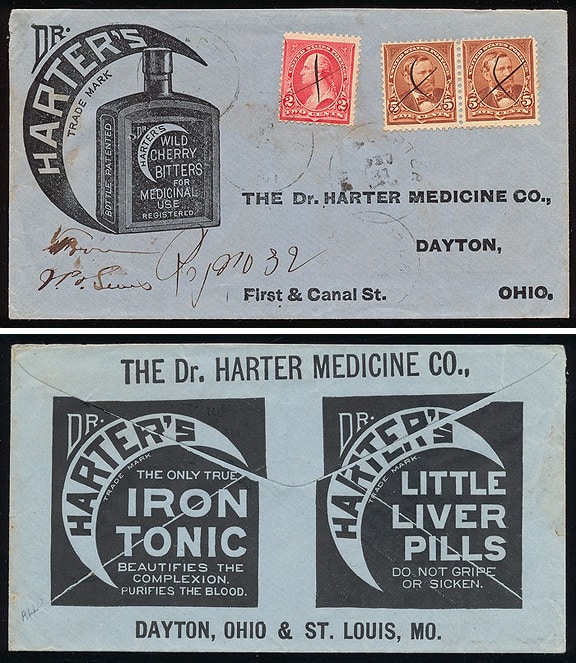
1898? Pictorial advertising cover for “Dr Harters Wild Cherry Bitters for Medicinal Use” with picture of bottle & all over reverse advertising, franked Presidents 2c & 5c pr with m/s cancels & tied by indistinct” … quarter” cds – Stamp Auction Network
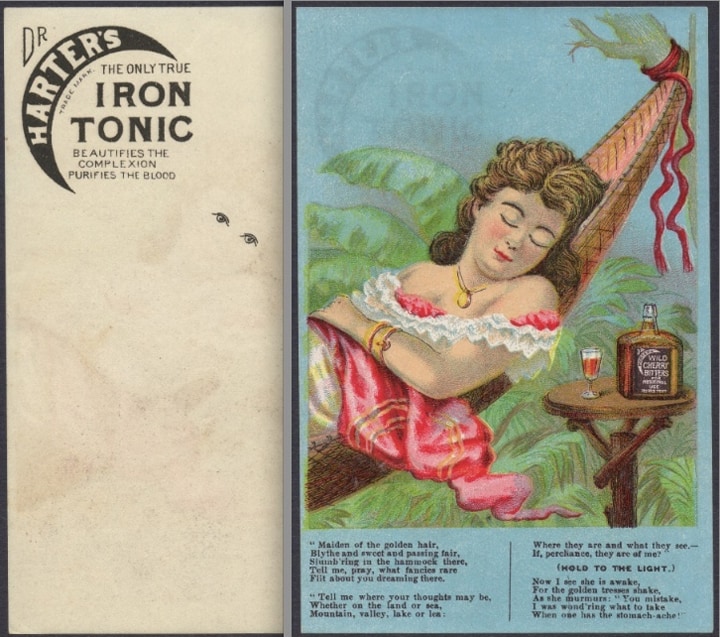
Dr Harters Wild Cherry Bitters Blood Cure bottle poem HTL Advertising Trade Card – DavesGreatCardsGalore.com


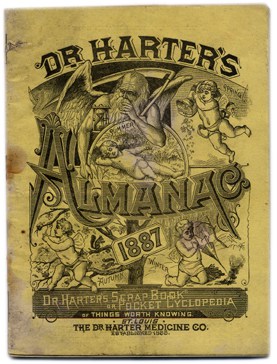
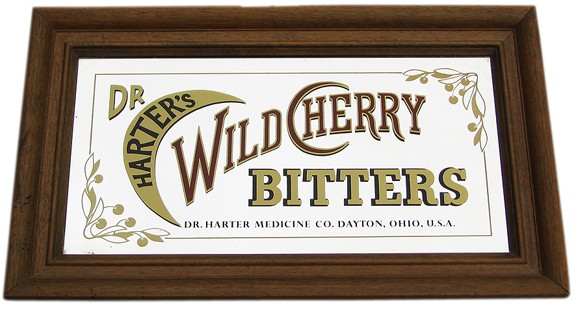
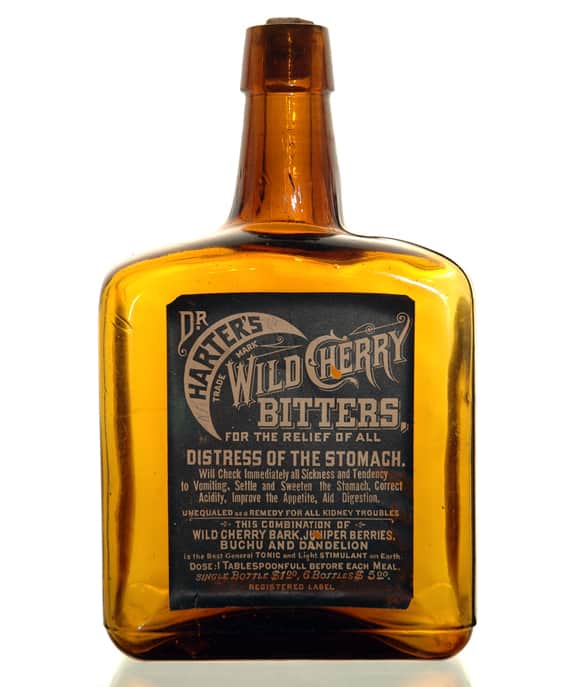
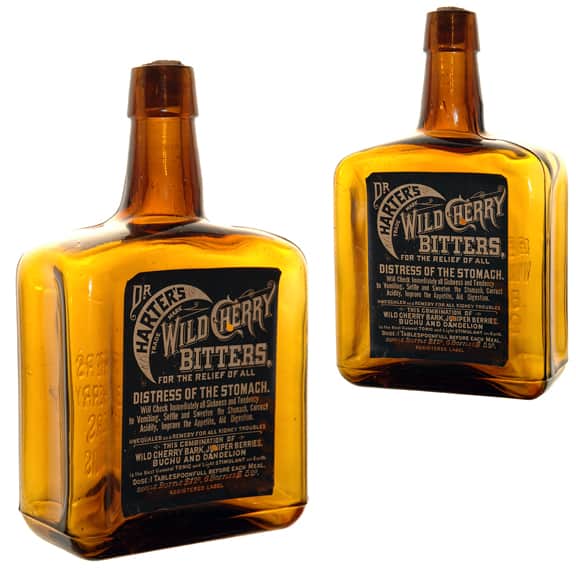
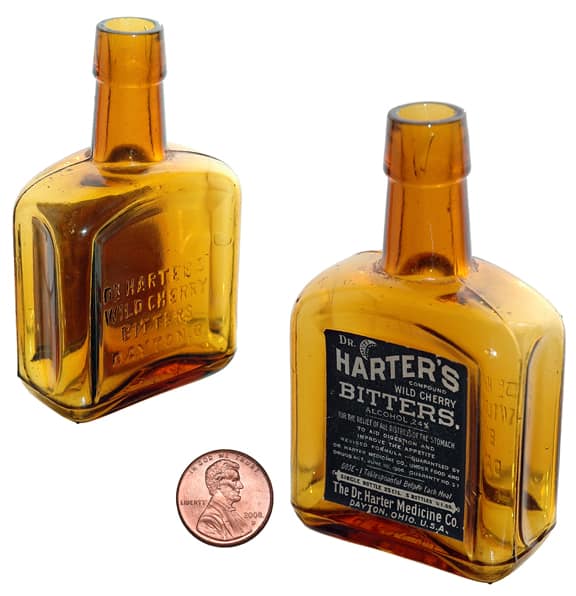
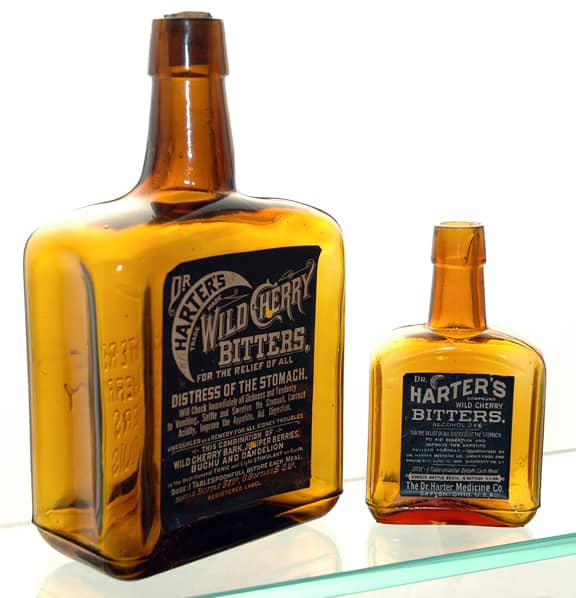
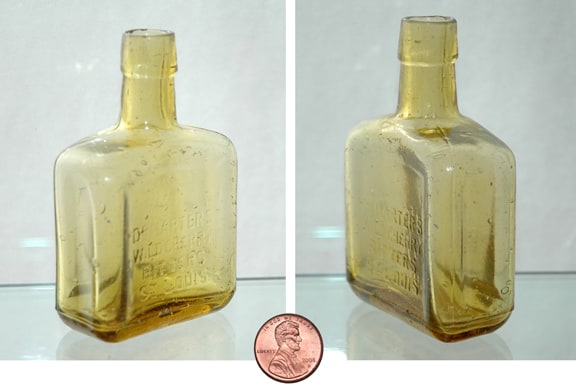
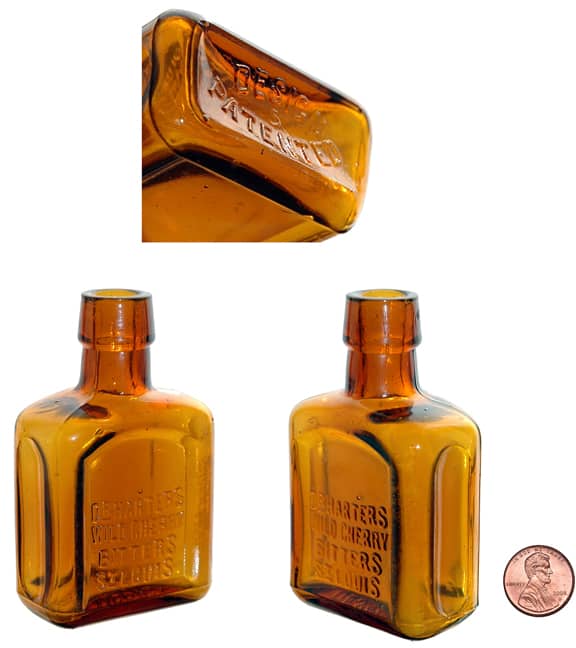
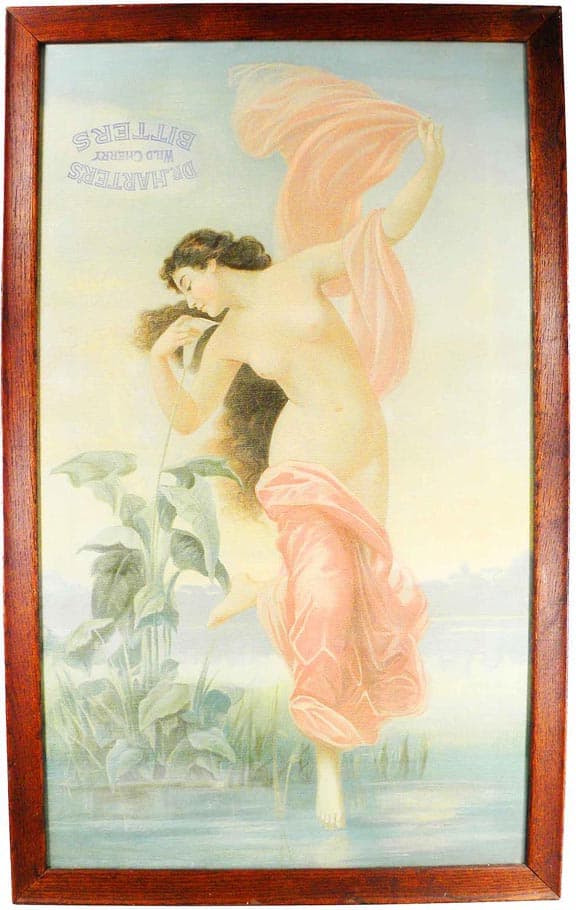
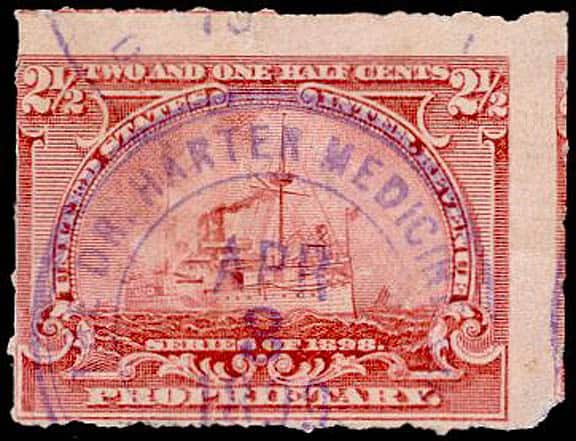
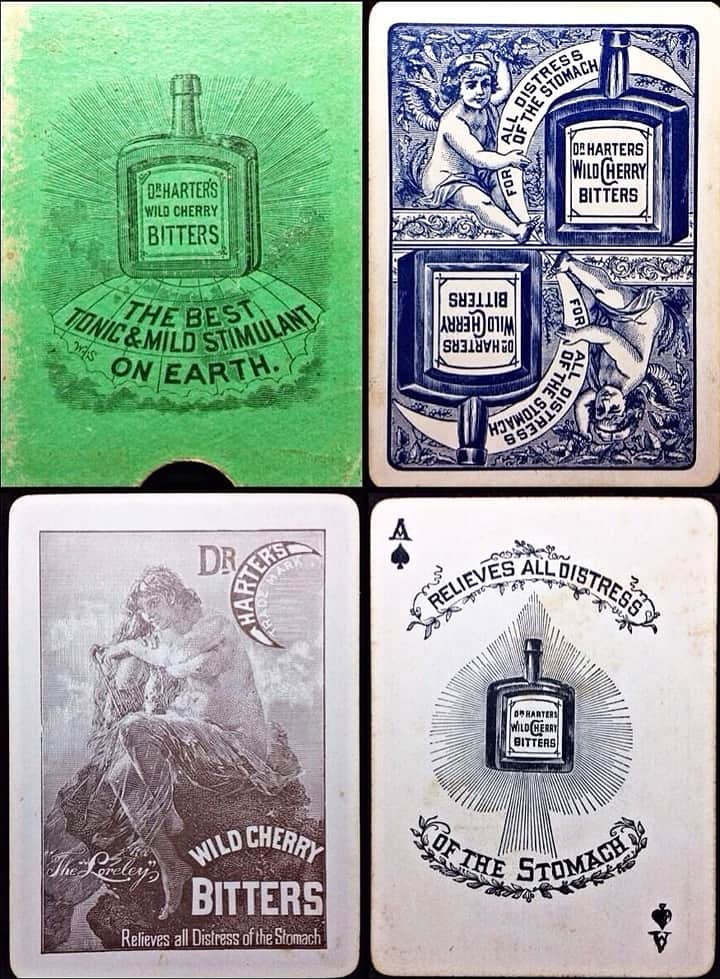
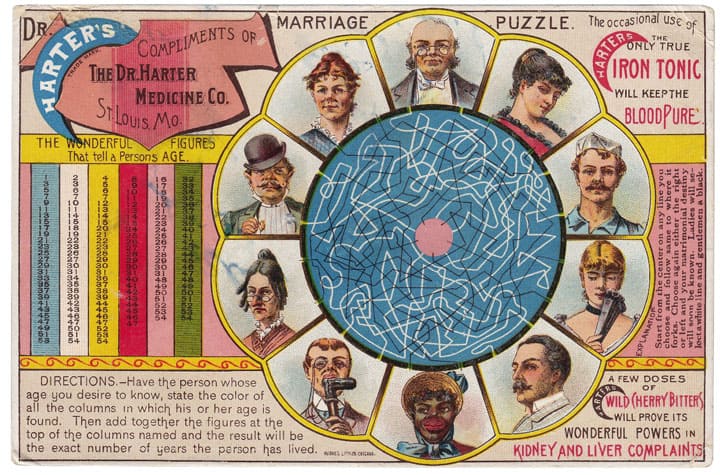







Added Dr. Harter’s Iron Tonic trade card image.